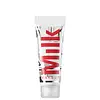What's inside
What's inside
 Key Ingredients
Key Ingredients

No key ingredients
 Benefits
Benefits

 Concerns
Concerns

No concerns
 Ingredients Side-by-side
Ingredients Side-by-side

Butyrospermum Parkii Butter
Skin ConditioningSimmondsia Chinensis Seed Oil
EmollientCaprylic/Capric Triglyceride
MaskingSilica
AbrasiveKaolin
AbrasiveOleic/Linoleic/Linolenic Polyglycerides
EmollientC9-12 Alkane
SolventTribehenin
EmollientVp/Hexadecene Copolymer
Vp/Eicosene Copolymer
Octyldodecanol
EmollientGlyceryl Rosinate
PerfumingTocopherol
AntioxidantAscorbyl Palmitate
AntioxidantSr-Hydrozoan Polypeptide-1
HumectantGanoderma Lucidum Stem Extract
Skin ConditioningTremella Fuciformis Sporocarp Extract
AntioxidantCandelilla Cera
EmollientRicinus Communis Seed Oil
MaskingSodium Hyaluronate
HumectantDisteardimonium Hectorite
StabilisingWater
Skin ConditioningCitric Acid
BufferingCaprylyl Glycol
EmollientPotassium Sorbate
PreservativeCI 77891
Cosmetic ColorantCI 15850
Cosmetic ColorantCI 19140
Cosmetic ColorantButyrospermum Parkii Butter, Simmondsia Chinensis Seed Oil, Caprylic/Capric Triglyceride, Silica, Kaolin, Oleic/Linoleic/Linolenic Polyglycerides, C9-12 Alkane, Tribehenin, Vp/Hexadecene Copolymer, Vp/Eicosene Copolymer, Octyldodecanol, Glyceryl Rosinate, Tocopherol, Ascorbyl Palmitate, Sr-Hydrozoan Polypeptide-1, Ganoderma Lucidum Stem Extract, Tremella Fuciformis Sporocarp Extract, Candelilla Cera, Ricinus Communis Seed Oil, Sodium Hyaluronate, Disteardimonium Hectorite, Water, Citric Acid, Caprylyl Glycol, Potassium Sorbate, CI 77891, CI 15850, CI 19140
 Reviews
Reviews

Ingredients Explained
These ingredients are found in both products.
Ingredients higher up in an ingredient list are typically present in a larger amount.
Ci 15850 is the pigment color red. It is an azo dye and created synthetically.
Azo dyes need to be thoroughly purified before use. This allows them to be more stable and longer-lasting.
This ingredient is common in foundations, lipsticks, and blushes. This color is described as brown/orangey red.
It has many secondary names such as Red 6 and Red 7. According to a manufacturer, Red 6 usually contains aluminum.
Learn more about CI 15850CI 19140 is also known as Tartrazine. Tartrazine is a synthetic dye used in cosmetics, foods, and medicine to add a yellow color.
Tartrazine is created from petroleum and is water-soluble.
Some people may experience allergies from this dye, especially asthmatics and those with an aspirin intolerance.
Learn more about CI 19140Ci 77891 is a white pigment from Titanium dioxide. It is naturally found in minerals such as rutile and ilmenite.
It's main function is to add a white color to cosmetics. It can also be mixed with other colors to create different shades.
Ci 77891 is commonly found in sunscreens due to its ability to block UV rays.
Learn more about CI 77891Ricinus Communis Seed Oil is the INCI name for castor oil.
Castor Oil helps moisturize the skin. It is rich in a fatty acid called ricinoleic acid. This fatty acid helps prevent moisture loss on the skin. This helps keep your skin soft and hydrated. Ricinoleic acid also has anti-inflammatory and pain reducing properties.
Besides hydrating the skin, castor oil is also used to hydrate hair. By keeping the hair shaft moisturized, breakage is decreased. More studies are needed to show castor oil's effective on stimulating hair growth.
Castor oil is created by cold-pressing castor seeds and then purifying the oil with heat. It was used in Ancient Egypt as fuel in lamps and to help treat eye irritation.
The term 'fragrance' is not regulated in many countries. In many cases, it is up to the brand to define this term. For instance, many brands choose to label themselves as "fragrance-free" because they are not using synthetic fragrances. However, their products may still contain ingredients such as essential oils that are considered a fragrance.
Learn more about Ricinus Communis Seed Oil